From Sarah Thornton’s Seven Days in the Art World:
Since the 1960s, MFA degrees have become the first legitimator in an artist’s career followed by awards and residencies, representation by a primary dealer, reviews and features in art magazines, inclusion in prestigious private collections, museum validation in the form of solo or group shows, international exposure at well-attended biennials, and the appreciation signaled by strong resale interest at auction. More specifically, MFA degrees from name art schools have become passports of sorts.
Leslie Dick, the only writer with a full-time position in the art department at CalArts, told Thornton he asks students the following question:
Why come to grad school? It’s about paying a lot of money so you can change. Whatever you thought was certain about how to make art is dismantled. You wobble. You don’t make any sense at all. That’s why you are here.
Dave Hickey told her that he doubts the value of that process.
My one rule is that I do not do group crits. They are social occasions that reinforce the norm. They impose a standardized discourse. They privilege unfinished, incompetent art… If you’re not sick, don’t call the doctor…
I don’t care about an artist’s intentions. I care if the work looks like it might have some consequences.
I’m with Hickey on this one. Doesn’t Dick sound a bit like a cult leader? If you’re not sick, don’t call the cult leader. Paying a lot of money to study a collective version of the meaning of meaning might make sense in flush times, for those inclined. But for those who don’t have family money and are going into debt for the privilege, I think its virtues are overrated.
I’ve been thinking about this since Todd Simeone opened at the James Harris Gallery. Simeone was showing in Seattle before he got a BFA from the University of Washington in photography in 2005. By the time he left town to get an MFA from the University of Illinois at Chicago, he was on the regional charts with a bullet, ready to hold his own in a larger context.
He believes that graduate school helped him focus, and that may be true. What’s also true is that it appears to have (temporarily) killed his spark, his juice, the thing that made him singular – a commitment to imagery that makes an electric connection between audience and art, allowing them to rearrange and enlarge their understanding of the world of things.
I also think, for someone like Simeone, interested in a progressive version of the landscape, there’s a lot more going on in that vein in Seattle than Chicago, where he is now and his Seattle dealer advised him to stay.
Early Simeone (My reviews here and here)
1. Record Cover in a Flash (Air Supply) 2006 Inkjet, 28×28 inches.
2. Suitcase 2003, Inkjet, 24×40 inches
3. A Chart with Peaks and Valleys 2005, Inkjet, 45×76 inches
4. Six Ways to Roll Seven, 2006, Inkjet, 14×14 inches.
5. Record Cover in a Flash (Temptation), 2007, 31×31 inches
1. Far Beyond, 2009, gouache over Inkjet on Stonehenge paper, 22×30 inches
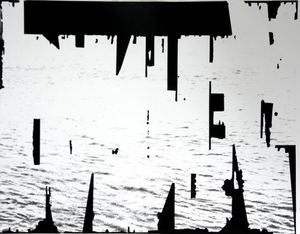 Broken
Broken
words over water. Words as eroded piers over water. It’s admirable, but
in Charles Wright’s image, it’s the spider’s web without the spider. It
can catch, but it cannot kill.



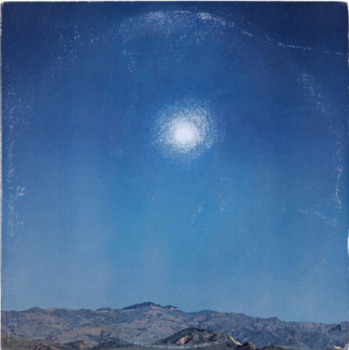
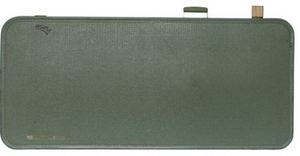
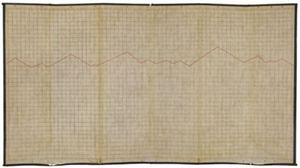

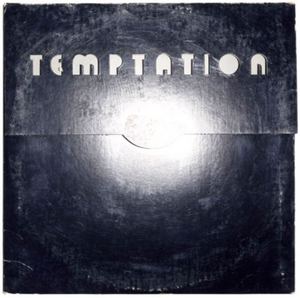
I don’t know how you do it. Agreeing with that arrogant bit of drivel from Dave Hickey. Regina… I haven’t felt so poorly towards a misguided and thick headed Art pundit since Pincus-Witten.
JVK
When Martin Puryear went to Yale, he was a realist painter of barns and boats. Chuck Close showed up painting like De Kooning. They are two cases in which graduate school served a key purpose. But I think for lots of artists who have it together already, why go? Such artists don’t need the graduate school doctor. Dave Hickey is arrogant. That’s his style, his persona. Wouldn’t work, except he backs it up.
I never wanted a degree in art. Mostly self-taught, I noticed that many artists come away from schools with art that looks like their instructors’. Degrees are definitely a way to get work teaching, part of a “network” to get gallery and other shows. One makes choices.
Art is an itch that must be scratched.
The recession has made getting teaching jobs more difficult, but see this Frieze article by Robert Storr, written in 2005:
http://www.frieze.com/issue/article/view_from_the_bridge4/
My motivations for attending graduate school were to position myself outside of (provincial) Seattle on a good edge, be shook up as an artist, and to have teaching as an option. Half way through the program at The School of the Art Institute of Chicago, I became half-hearted about teaching, doubting I had the temperament and I did not particularly care for the glimpses into its political environs. I ended up sending perhaps fifteen apps with no interviews. Another grad put out ninety to get one interview, which worked. It’s now well known that College Art Association meetings bring in money for the CAA and put out many a dashed hope for a teaching job.
As far as what it did for me as an artist goes: it was not absolutely necessary, though it was a thrilling and grand experience otherwise. I was not turned on my head; I already knew where I was going. I did not need to be shook up as my self-mythology insisted, at least to the degree I then thought. I did have my horzons expanded and was exposed to major art and artists that I would never have seen in Seattle. But the clouds, so to speak, did not part.
Were I to do it over, I would not have gone. But the reason is debt, which will dog me the rest of my life and never be paid off, and that is no exaggeration. Fortunately, the USDE is being flexible (for now). I would get a BFA, for sure, but largely because artists need to know much more than art to be artists. We need to know how to write well, study science, history, language, and on and on. All of these things and life experience make an artist. Maybe the actual practice of art should be only half of a BFA.
I would only go to graduate school if I were rich, had substantial scholarships, and-or knew an in demand trade that paid well and I enjoyed to pay back those loans. (Education loans I think should be interest free, but that’s another subject.)
Lastly, I feel I must take issue with Sanda above: no such thing as a self taught artist, just as there is no such thing as the self made man. Whether you go to art school or not, you will only learn by doing the work yourself and being guided by someone. “Self taught” artists can’t operate in a critical vacuum. And if you don’t go to art school, and you go to museums and galleries and turn to books and magazines for instruction and insight, you will have to ask what their academic connections are. “Self taught” is just a marketing device, as is “outsider”.